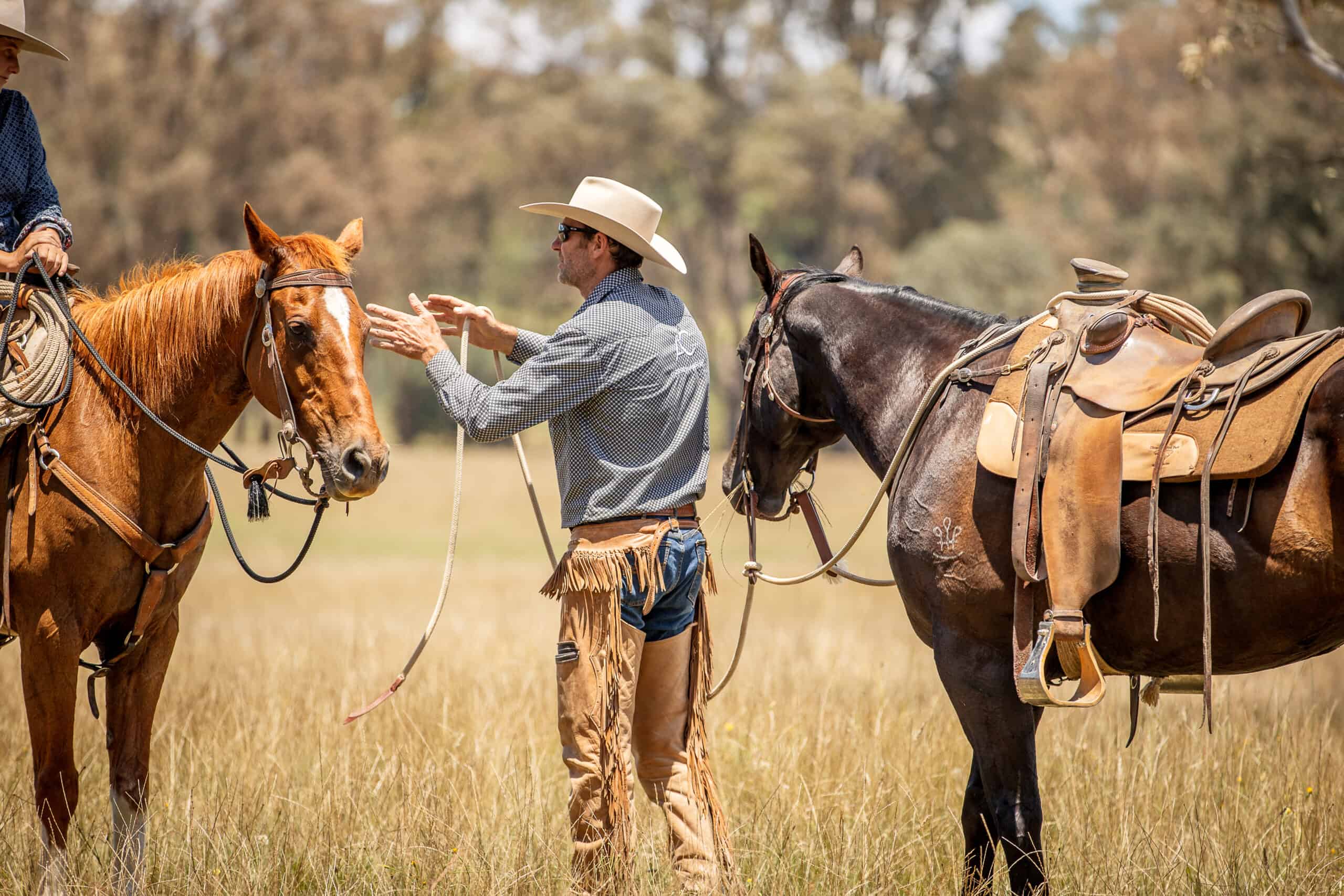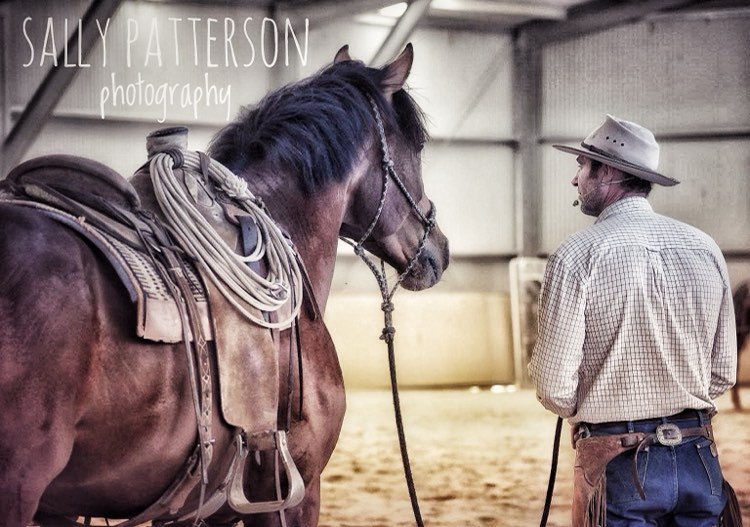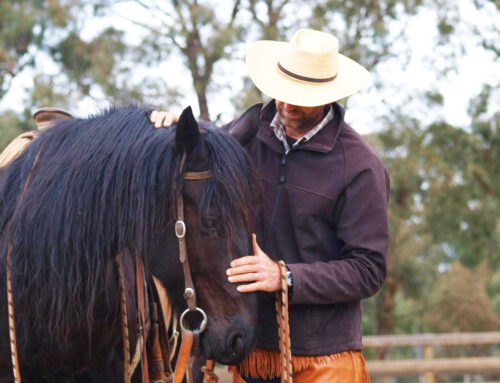According to the British Museum, horses were first domesticated around 5,000 years ago in southern Russia and Kazakhstan. Forming this relationship between our species and theirs changed the course of human history. Without the horse, our civilisation would not be what it is today.
Despite these thousands of years of coevolution, the bonds between people and their equine companions can be fraught with tension. A breakdown of the horse-human relationship is frustrating at best and dangerous at worst – for both parties. This is where horse trainer Allen Collett comes in. He provides education, or re-education, for horses and their owners so they can work together harmoniously.
Allan’s approach to horse training revolves around two-way communication: humans and horses learning to read one another.
“You’re holding a conversation the whole time you’re working with a horse,” he says.
“There are three terms we use in horsemanship: feel, timing and balance. So most people can have balance because they can ride – they sit on a horse and most people can go with the horse to a degree, but an inability to do this creates a lack of confidence in horse and rider. Feel is what you present to the horse depending on what the horse is telling you.
“Timing is knowing where the horse’s feet are when you’re riding them and you’re asking for the foot to move. Timing also comes into the education of a horse in the form of release. By this I mean release of pressure from an aid for example. Pressure motivates a horse to seek relief. When the horse gives the desired response, it’s up to the human to release pressure, and that tells the horse it’s done the right thing.”
This description of horsemanship stands in stark contrast to what Allan practiced when he began his horse-training career on the racetrack in his late teens.
“It was more of a production line. In racing, you just want the horse to get from A to B as quickly as you can. So everything else can just go out the window. When you get any discipline where they go hardcore on one thing, they seem to miss a lot of other things,” he says.
It was only when he encountered a particularly difficult racehorse – a “problem horse” – that Allan sought alternative techniques. Someone suggested he see natural horsemanship practitioner Wayne Anderson, and this sent Allan down a completely new path.
“I watched Wayne work a few horses and that blew me away. I thought, ‘Wow, this is something else.’ I couldn’t understand it, but it looked good to me. So I worked a bit with Wayne, and that changed the way I did things.”
Now, observing Allan in the ring with a large and visibly nervous gelding, it’s easy to see why horse owners are seeking his expertise in droves – so much so that Allan typically works 12 or 13 hours a day. As the horse dances around him, Allan radiates a calm energy and talks through all the information he’s gathering from its body language. Gently but firmly, Allan gives the horse signals by positioning his body to elicit desired movements, and the horse responds. It’s clear that the two are feeding off each other and gradually establishing an understanding.
Allan’s methods are derived from the Spanish vaquero (cowboy) tradition, which originated with the Spanish cavalry. This style of horsemanship relies on finely-honed communication between horse and rider because cowboys or soldiers must perform complex tasks while riding.
“With the war horses, they had to ride one-handed with a weapon in the other hand, and their horses had to be responsive – it was about survival. They took that into roping and cattle work. I’ve noticed that most of the really good [horsemanship] clinicians from overseas have that background, I think because it’s so advanced. When they’ve got to ride with one hand and have something alive on the end of their rope and control that and have the horse work with them, it’s a whole new level. So all your groundwork and your preparation work is at such a high level because the end product has to be so much better,” Allan says.
He points out that his approach isn’t just for those who are interested specifically in the vaquero style; it works for equestrians with a broad range of needs and goals.
“I work with people of every age and every discipline. I think the main thing is getting that foundation laid, and if you’ve got that foundation, you can do any discipline you want. In general, if you know where the horse’s feet are and you’ve got them working with you and you’re not flat out controlling the horse, it’s just a matter of, ‘tell me the pattern, and I’ll go and ride it’,” Allan says.
At the end of the day, for me, the horse is my feet so I can get a job done. Having said that, I want it to be effortless, so it’s just a thought – I’m thinking about it and the horse can feel the change in my body and he’s following that feel.”
While Allan acknowledges his approach aligns with the principles of natural horsemanship, he qualifies that it’s not really a natural process for the horse. It’s about integrating the horse into the human world so that it is comfortable.
“People call it natural horsemanship, but it’s probably not really natural because you’re putting a predator on a prey animal’s back and strapping a dead animal – a saddle – to their back. So I think the ‘natural’ part of it is more about trying to work with the horse in an unnatural situation, but tap into how the horse thinks, how it reacts, what triggers it,” he says.
“You work with that natural sensitivity a horse has, and then you almost try to desensitise it down to the point where it can handle our world. And that’s my job: to help prepare the horse for what it’s going to experience in the human world with traffic or something stuck around its leg or whatever it’s going to be that might freak it out.”
On the flip side, humans must also do their fair share of learning to build solid, healthy relationships with their animals.
“Most of the time you’re trying to turn the people around, it’s not their horse. You get the horses good, and then you’ve got to get the people up to scratch. A lot of people want what you get with a motorbike: you get on and turn a key and it goes. But it doesn’t work like that. People need to come on board and look at themselves,” Allan says.
“Sometimes you can get a massive change in the horse. Then if you can get the human to change too and have confidence in the horse, they’ll say, ‘I can’t believe it’s the same horse’.”
To help get horses and humans on the same page, Allan trains horses and offers private lessons on his property in Alexandra, which is set up with a riding arena and training ring. He also runs clinics at various locations in Victoria and interstate.
“The clinics are with bigger groups – you might get up to ten in a group. The beauty of a clinic is that you get to see so many different examples of doing good and bad things. They’re great for observation and there’s a lot of people to take in.”
For those who take up the challenge, Allan says that developing high-level horsemanship skills is an ongoing process – he still comes across horses that teach him new things. But it’s worth putting in the hard yeards.
“At first, it’s like drinking out of a fire hose – it can be overwhelming. But as you do it more and become better at it, it becomes more enjoyable.”
If Allan’s experiences cultivating his horsemanship are anything to go by, people who follow suit may reap benefits that go beyond having pleasant equine interactions.
“Horses force you to change a lot of things in yourself. I had to change. Early days it was an emotional roller coaster. But you learn to be more emotionally stable and be more tolerant and even look for the good in people – it’s just like with the horse, you’re looking for that good outcome,” he says.
So, just as human society as we know it was shaped by the inter-species relationshp with horses, connections on an individual level can influence the courses of our personal histories. Or, as Allan puts it:
“Horsemanship is a journey, not a destination.”
This story first appeared in the Murrindidi Guide, Winter 2022 edition.





Leave A Comment